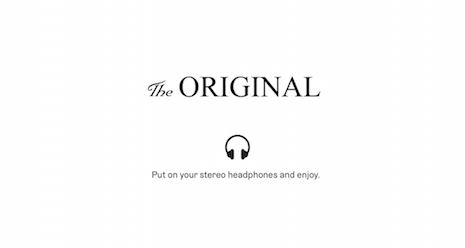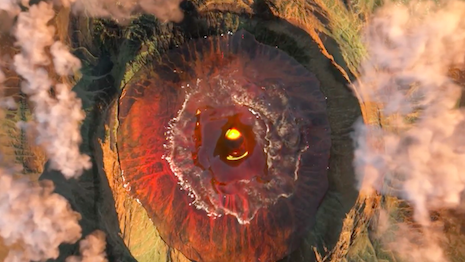Scottish distillery Glenmorangie is rolling out a new sensorial advertising campaign based on the phenomenon known as Autonomous Sensory Meridian Response, or ASMR, to allow customers to “feel” the taste of three different whiskies.
In three short videos, Glenmorangie communicates some of the sensorial effects of its whisky through the use of soothing audio sounds that trigger the response known as ASMR. Through this campaign, Glenmorangie is offering customers a proverbial “taste” of the whisky without them drinking a single drop.
ASMR
In Glenmorangie’s new advertising campaign, the distillery is relying on the phenomenon of ASMR, the distinct tingling sensation that can be produced in human beings through certain auditory experiences.
ASMR is often described as a type of low-grade euphoria as well as a way to connect the auditory and tactile senses similar to synesthesia. Some common triggers seen in ASMR videos include whispers, dripping water, scratching surfaces and shuffling papers.

The notice at the beginning of each video. Image credit: Glenmorangie
For Glenmorangie, the distillery is using this connection between hearing and touching to give customers the ability to “hear” the taste of Glenmorangie whisky. As whisky is not something one can easily try before buying or get a sense of just from doing research online, Glenmorangie’s campaign is an effort to give customers a taste remotely.
The three short films are elaborate creations, using a combination of impressionistic imagery and the vivid, immediate soundscapes that typify ASMR videos. Each video is dedicated to a specific whisky such as The Original or The Lasanta.
Glenmorangie worked with researchers who study ASMR as well as visual artists to help create the videos.
Auditory response
This campaign serves as a way for Glenmorangie to gives customers an experience similar to what it hopes drinking some of its whisky is like.
While the use of ASMR is new, Glenmorangie has, in the past, made its products part of a transformative new experience.
For example, Glenmorangie is repurposing its Scotch whisky casks as a mode of transportation.
The distiller has teamed with Portland, OR’s Renovo Hardwood Bicycles to upcycle its used casks to create a one-of-a-kind bicycle. The collaboration serves to celebrate the Scotch whisky distillery’s history as well as its wood management policy to leave a smaller environmental footprint (see story).
Glenmorangie has also extended some of its recent campaigns towards more altruistic goals, such as making its manufacturing process more sustainable.
The distiller has launched a two-fold project to clean the wastewater produced during the whisky-making process.
The Original
Glenmorangie’s projects will work to purify and clean the waters near the whisky brand’s distillery on the Scottish coast by reintroducing native oysters and through the opening of an anaerobic digestion plant. Across sectors, brands have launched corporate social responsibility efforts that work to protect the environment from manufacturing (see story).
With its newest marketing campaign, Glenmorangie is taking the bold step of banking on ASMR, which is most well known in the niche online communities that produce ASMR videos, in order to market expensive whisky.
But the synesthetic combination of hearing, touching and tasting may work to the distiller’s benefit as it could give customers an intriguing glimpse of what each whisky may taste like.
{"ct":"R5Et+q2MDnzLcXXtzzGhsSidwkReYUZdVSdLkd7UHv82ZkAntKgfuwCuZgC1fR8Av1gyAmei+yH0wd6pp8J+Fl9cP1h\/9o1hJ3+WrHWiGrHRHV4iGbLMXw6Wof0KoGfR7emvh7regoUI8lewXNzqdsP5U16fmmiiXeIhvqe+rr6nbg5eDTx\/QkyOn0b\/ZJOYYHXQwYM2phJFVjkmAQ4Oj9FKvw4cF682LdOdl47rQT\/pQcgsoHCSuXSJ9GFo2c3NxIRcq9uabn7\/KwBsLSHP7uirGP6x\/3Cr3FhtfVCpVcLufENQo3b4fOcg7a4Hty443k9uki3BfsR0LZtmlc8LsjvAn2M9QRpI72P8NJZufjCBAwxTEUFgLgmHllPxYTnvwHx8Xz5Nznuo2mjKO+\/\/XSa9PsY8BjozDQ+FPmTYYKfdxdhJMdJqV9PhlidoZEVTSzgjdbNrjEXvBOTDpZlQ\/l+tNZSVYXbhY1bS8EZfTIS0YGSDKlQEjbbnPr6xghW6PnX0MTpCsaxieOsbvR88+KbQ6NX1CaFvhPbVrkIqQApcgvaJVRFjIZPHj1vrzrX+3EGehnwazdaaKDPJH\/jXPfB\/Z7HhsuabpTM2tcEnefGmmwl0FW19dUBNZPk5Lv5Cy69bsz7I4CXtksMBSSpZzfFrm57cZS2w9CDHLVdkIvGo5aDEJ4UcjXDavZJRgwqVirMazM+RcczI8RT2Lu9Uzs4i2BD2pESbuf7qgurQbPLacok3OFPe0xJZAYLTfY4bMYL1Lba6M5WCIWylHR3jUPUoCP4FHN6WC6N1utmKWGsGKniiG6JYeoL72Ykb4O89hOPl5w8sXrw76WWo8eg9ea+xtRyoqfhJ5Hvq09GBst8x+bsLvZXQco6KmZrBHNMGd9hg\/AnStlKtmXklkp4rRQpBTnhyaWalH2yBcRFuNZ178gClKqCfd8hpVPjl1KgAeP7Y7VaD19EOiBKu4mhxPiaa4jmaXqOcvMoFo3JOwn9U4hrJ3hnzo42wLH94IM1mVpTlje4q2jhr7oo3ucnazIUCbjFlIq+jHy6oQhVEaVdr9cLBY1DToZL12NxDM28iBoufSgYH7y1ogJRlTfdVC1qyCXfSOE\/3wA98gb\/Lx02NU7b7N6eM91nCARR4q+0yhbMus3w6XLsiMFnottBT0Uh6JVLHJ+Yx+Oh0sCtB9hirGvXTKv2tJ\/OOeXAlHBpz6varVgIi5bmSFtdBkR3rZPzoFo2+ppYJ+lHVq\/cI5WvO\/qjHCIPf+E2uWFjuF7L4gonmKr1sR0OW73sBGsHUXwNoSnqc9Fbm9Pvw6cdzWd2AM0SSvskbeoUJ+HRTzkUSHQS3drn2ksTJyGGKd13q2ASk8mbmTg9TpboJvk+P6x5NE2pKeGpjgC1eUqy7tK7XAfIIy3rZ0\/4fuH7\/THRRc5WG\/Fcq2hj0lEKj8672piwo\/QHJ+lqTRWVjmZ4mqQ2YpQ17JP2D+bgOUvHbARoPXjMgNCgtDOMFn+tDiZqa6RvBWvZk3ffAOn8ckM4TlgxaL5SfDW6WWzUPDK+K6HpTmgZN6TSeT8a7HvzbatHcdM4sIPYwy3BhVOda70fbTyzjsmX93SsAFsIl34kaZmkzo3YWNf\/vCihxmDY2YArXm08by6N0BfckZGdlpl1gS\/DpBSvpFRbrYHNYSq1RWp+O9lNPVlHtUD+yAZRIjS6pIy0mTIVf1X9VSp0pO6yZODtsNAlTv9+9dt+kizAvQw\/fILCpbIA5OZ8DMYoXa3EWd9\/2XZrdVSHL1XEW84RRSELyHg+Y63uswLZUBvS2c7BlGFBuX6bRFnlLyn9oK+XA378cFb3RCxnDcAkfbRxsivJAkUg\/POWQnjbuLo2fDcnVenkgswbIx\/JWlfifmq2O9BqFdT0YklKN+Xnxf6CLoLfHJmtFjQiLUGY3ND\/5KrS7C3Un5nhU5GJSrUhTpkcR4ktVFiWlGG77ekwjStN8oGZGGsUtD2KBE7FAQUCfgfODS+cLzWGWOUT\/kPvpbshfk98c6y+vHiYFdcpFHJD8pnh2DfIqvi4xEl1qmIgGoEv7fWvvCZsnZE6KwsT3dyy6Bu4deoVqEyAJGbWM\/LNlBbk75Z3ou6\/amcVPfGaoOpbpbxRYDi77cDvYBTAU3K8R8WohYlXKSe3Q\/3duXcUBM5O+X0lqib21\/rnV2pPdw4ztQChE4n94vNzmC0F4FY+I9BLsgec2GeyoYXIa1s+aKe\/jKsGIjdzke+F0b2hPDRy3r\/ssqXrSRE6JN1uQYFjUC1jcxX9lDpGTVJ8DX2aoXgMNXdEx9aberY2Ogy6mOF3oW0iJRcHzRuMfDldFRQ+mTqrV9t7Kv8xWXygB+Yal9vBrvrehnRuNYiGg5r2b00BH8UG03Z4fA4HV\/EBDO\/Br3e1ORsOYTUlFgClEUTY\/646lW9f5UXxYrOjl1D2UlVAYeDHSb+gt9KIKUq2+pkjU\/1Wl0gP0xJEDl56+ekJGm+QVaP4AdD1oT44DBIzRIK7mho7OWe5oXn4YDzjsfWgXsPZj4jW4DFjzV2MZisDyYzj2wKluKVP7\/w7Xd1d7aHHjtjigudzt+pEsJBGE0LP6k3kRIMxiIh9c4EUWorwKhbbvjH4T2J0RV+1uZGdHrTjgaH6uhL6jSkm2J2IeSQBGqUzNA+UCvz9QSnp9WT7Vxh2hroZFslUPhcRzGslNN3BKyqLtteIVhKjQtyoQ62+onLgfXzmDlEnRX8vf0v1mrxX2C8xhKsACgE0kGJtgxjGO3Bd2zCA7nAc+xqWQr1ZOCAhr6coROKYNjl+ApPQ1gmD88unfqiKD43DGYJOCCf75Ym\/RvtusJXaSP3cvzuIcelE6Bluak8+Gek6bjvcoyZJDcit9v8WYHJqC5BdJEpsn4\/X1rENJK4OsYzUEEcxkKVwda6P33X8cTM226P6nhYZ4JZK7GRcfNs4c7WxVh1GZB3mMk6Q\/YP2CI23Aw1fydqQ+mZn1lJrvygQjtzQjJB5vLNgjLoJxpU31jJ777CmkXwnuIy+gQfgOSZALRdyqXWusRLf55zn2sXR\/FOQ4c9W15G\/rJPnbnJUV5+HIswqzCCSvhfEdH33Z16VWYDLGsNJG3NwUL284AgK+GNDah41Pq6SZHuDP3LQIxob\/YQtgPypTUHq1Ghz0I7TxzOVIWnUU+2DT8sOWfmDGikbRep07mPgFnKCFDixMjcH1bdJEFmvQSxMH1p+wyHP3cIMUjWrLXekQBeWM1CYzXJQC5cNjdmZMQclP5hGdq1yCpwQ3uzs1jmwzKU4LKgYY+khwmjjQO0nTybMpi01Wcrta4LTnE51sgtNFyBnvdxX1wrOOclAPMdGgWhWn+rE9WZ1SSUP5vs4kenV1bkkAaVjGCaDEqZJXbsAsGJgN2c1Fc4GbPgaI8jqpCPHHWSgog9FOL5awO3GXGZC6\/3scDlslne1CzlFtwhVFMrK+SGbgpiSUXfX33Vw4VOIva4c3IPVUYsuECsFA479jUBYcnLPVtwfpw\/pqPgZS9HJ+5vzqkzHerf5JP112h\/CT1YpbodCLBCE4SqjM8Aujvu4v4eOZpjcyhj+cTYcm5dz\/E2Ju+NIFzVLtXW5aCwSP8Rx3ouYlAEM2ANtAs9I1Wnnf1nqvz90HNjaAp5F\/hvDm2cbMFXTLZGw1sV5bMHLVsUKeiP1IG5WyVzYecSj3q3pnNs5\/Ky8fVv9UFYBRcjtlmz7kg\/L\/p8TR3JzKZlC1v5YsamGVaAgbAY0KWDnh80Zi2JhtfTBN0iToX0dbwyC3VQWLjY7p4UBFjvZ+OzTK0KyGuYnsWB8+OFfmxr+hu+DiLnM1HpP5snEMiNlFrCI\/CNDahqJVLHR7vuZRVmVgPF1tv\/TZIomUUN3Ldh0QBqu3B7jGBRIeT7jp1MrMuSetFe1bfhCYyZRG5IosMlzShKUy9GS\/y\/XZniLDsMjUn1ITHFoS2+RdP8s8V7pSnN8n4XqzQCcUkMH2W6l2fBd13epJNFYhvWl7gCgQDSiOITqKeWMWfk6uq5GQE++4og05zh4wOcHQJfuLFzlwZ2dfNqJgUsBs10D3JEhZbsEV9fPHrl2tw93fRXbT3kqdeI6i3ch2MRbXxJKbAfIXTeXip\/OdJaUDO93HtAVISLm12Y3oTMTnbAPMk64afM8Oa1F8CoNONGAvgAw\/86MCMX5\/3VmbSJaKAvedatEE1xHuymO50m3oJe8tFC3hwHvoJRibLWB3UTMJO1NIPOKOQ6rEJwBnMjHNndTLheDZfG2BuQAlrKwacfy2C5UhKaWr19G7lA2HGunMHwBnTB54tSo21IrbSo8oWdsKn0SKduM46rlAZ8Gte27qXP\/7uC3TPODbrL+J86qu6LYBMRLC6TOe4d96Q2c+ZAa5fyqoQPy0G\/uOunUNC9l\/S6iDPY1zcQXigYUfwHnUGJAovAEA1sXiKfD9jq9sjfhLpOr8AMnZB0xxlvtyQcQcmBWEVbnx7N1NqDgRshjPvHVvttAdBMEsLZ975ijK5HeD9VFYFG7Bf61stfz8CBxp6lTJ37zBuapiG5MtomyJqGW6ghqKzvGxaXz1s+pm4meoHjwIajrpoqmGrkoU1Z7sTLYuup1S511mlL06taQTyOCqLyJjnGB3rOOXZbzK5K1bZ\/GSttgjOLynVAq6VUB7hG878Es2yvxqp7LAoxdp+xiNEFxhQaXCSH5rbXIwk5+fJhseItEQs5no\/uQfcerZg3uC6\/fKGuHWXnHTdSMygyFhDReMwZgO1ofE7XiXszdZPFTvgp4zDt27uq4\/3rh3\/DgHpIOWhvqVEoU9iGqc0RNdINiDURiKUbBZWqNB+e75O7drNmKiZ3xxvQFqmVmC92v5npniSRMUaZs9EyavERPATtB+\/Hjk1WZzd4+fXcbF7jBByx45QqvLSkofgsR1QRoYk3si9l+Q4IhAgPAc1fmH\/sOHi\/NgRl6gV4WJUsvJpNn2xRopLM\/jTKPFMlaIoQjTmxKmP8JyAZH4dHprFCMX87mEoh6QXs6JmM+u3KNDJsTeuOI0REUQc+cuNHR9n+J\/ptcfxYPlRIVOCZ52pilcHAeRV0bBztvBPcl3nTwSA0E3M07iqQ52Uxj+LQpshsJ7NbfWsj7rKbUh4ow8pc5gRG8IxUyPb4+LWqUdPI7uffxySZ5lIXG4FW634AZOxw2xICz+gB\/5RVgXydOrwvsYus30xz1IDWJhxdQHfQpAY81xWKyHAOC0SDpIArrFirrvslk42K56OijJO+MrCPrn9uhXOZCE2TLvsRrqTa\/Vu+AMJ+SMLWpM\/lQ8h1QWlEOK1+K6VR3tjywRqAEVnc3RdnNK\/EoHuvmPZYwIEATMo7xLkz3CgfuKMNPU7n6jyQC\/R7T\/sgZAdx4HiW5SLo0\/SZDTGrr7Ea37ID0APHpEBlgHebmdPSB4rNgsfslGpMLBycwDnTsS7LOG+cqPSCTZEu35PGWIzbmU7BLFXQi\/NoxSnvl\/icaHhHWMdaoVJNCh48vaNO8\/fT2\/zRMPw82xDFfbdqrPrgW+UeYXcZ4bQlX1yRc6RdvAU\/izxdKzcbkmn8XvCk1Etj\/K+wRXARAJ77sCtWKoCSUFrYCSH6qXcEjkpEE0emU\/vbYKXwMJvwKIa\/KDP72q1j+ZrpiidUssFUbgrhsozZc9Qta54W85P\/JzD5XMKVe7IKvj8bcVXKTqLuxbWSBqQ3lGWUCe1UCReAILudXs\/dzVLvBtjHp0KTVnQ3fAbrd4SMOIolCMTVVFffDvLykglIE5NoaHNSo+ab6wFGNHT08xs7Y5PpZlmj7PsrjbX0dIyDVSI2CIVD7PncKLpfyaNANx908BIW6VtrLZDaqsiLleBRRMaOixYjMHqsVwwxtyuEBslAX\/Y9hbOQSwnxlo9hG63nDNIlZiLMEWqTI21GDE91MByJCzS+pgGYUQhpbc\/tmaYE\/kN14qtvdfurkCSy7Zu+xPtXHmK24cKKVWn4VBsBcDGppM\/MHwBQaR1eOJuW\/HpcyC","iv":"5eab7200c2b92132b5d4cdb04e5865ff","s":"d7b5aab742726b90"}

 Glenmorangie's new video series relies on the phenomenon known as ASMR. Image credit: Glenmorangie
Glenmorangie's new video series relies on the phenomenon known as ASMR. Image credit: Glenmorangie